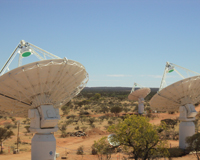PAF Installation Gives Green Light to Phase Closure
 |
 |
13 December 2011
Two more PAFs have been installed on CSIRO's Australian SKA Pathfinder (ASKAP) radio telescope at the Murchison Radio Astronomy Observatory (MRO) in Western Australia, bringing the total number of PAFs now in place to three.
The second and third PAFs were installed on ASKAP Antennas 1 and 6 in the first week of December 2011. The first PAF was installed on Antenna 3 at the MRO in October 2011.
PAFs, or 'radio cameras', are innovative receivers with many separate, simultaneous beams designed to detect radio waves. They will provide the ASKAP telescope with a wide field-of-view, allowing it to map the sky far more quickly than alternative technologies.
The PAF installation marks important progress in CSIRO's ASKAP project and, more specifically, is a significant step towards the major ASKAP milestone known as BETA or the 'Boolardy Engineering Test Array'.
BETA will consist of six ASKAP antennas in an array — with all antennas hosting their own PAF. The operation of the initial BETA array will allow both engineering and scientific commissioning to take place in advance of the full ASKAP array which will consist of 36 antennas.
Over coming months, the PAFs installed on ASKAP antennas at the MRO will be used in single dish and beamformer testing, and progressively, interferometric and phase closure demonstrations.
Using software and firmware validated at the Parkes Testbed Facility in New South Wales, CSIRO's ASKAP team will undertake scans with ASKAP antennas at the MRO on bright calibrators such as Virgo A in single-dish mode.
In the low radio frequency interference environment at the MRO, CSIRO’s ASKAP team expects to achieve enough sensitivity to determine first-order beam-weights, investigate a range of PAF and beamforming questions and continue to confirm basic functionality of the system.
Once reliable beam-weights have been obtained and the basic single-dish mode of operation has been validated, the next objective is to obtain correlation first on a single baseline (between two antennas with PAFs installed) and then on three baselines (three antennas with PAFs installed).
The latter should yield 'phase closure', an important step in calibrating the antennas and preparing for interferometry with ASKAP.
Other recent developments at the MRO include:
- Rapid construction of the ASKAP control building. All 13 modules that make up the building have arrived by road from Adelaide. The building’s fire suppression system has been installed and fitting out of the laboratories, offices and correlator room has begun.
- Trenching and road works nearing completion.
Nine ASKAP antennas have now been assembled at the MRO, while a further five antennas are currently being built on site. Two more antennas recently arrived in Australia and will shortly be transported to the MRO.
Back to Latest ASKAP News page.
